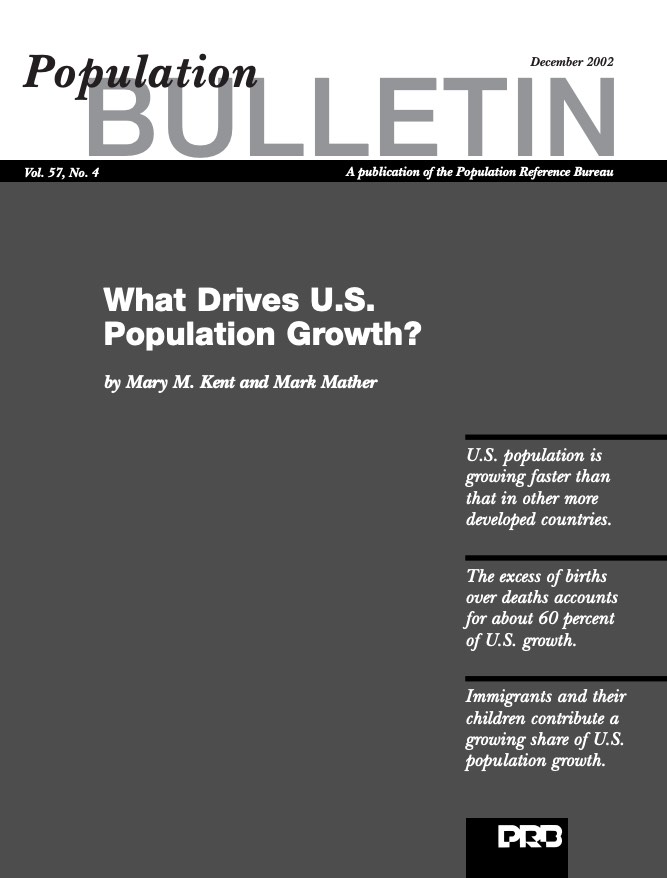
Diverging Mortality and Fertility Trends: Canada and the United States
Product: Population Bulletin, vol. 57, no. 4
Author: PRB
Date: January 13, 2003
Focus Area
(January 2003) Canada and the United States share a long land border and similar popular cultures. They are major trading partners and have fought in many of the same military conflicts overseas. Both countries are leading immigration countries, with the foreign-born population making up increasing percentages of their total populations.
With so much in common, it is somewhat surprising that fertility and mortality trends have recently followed different paths in the two countries. Canada’s demographic trends are becoming more like those in Europe than the United States. This divergence between the United States and its closest industrialized neighbor highlights how different the United States is from other more developed countries.
The Mortality Gap
Fifty years ago, Americans could expect to live longer than Canadians. The United States has made major improvements in health and average life expectancy since then, but Canada has made even greater strides. The U.S. advantage began to disappear in the 1950s and 1960s, and by 2001, a newborn Canadian infant could expect to outlive a newborn American by two years, and an American white infant by 1.5 years.
The reasons for this mortality gap are not easily explained. The major causes of death are the same in both countries: cancer and circulatory diseases, such as heart diseases and strokes. Both countries have similar cancer mortality rates, but heart disease and stroke are more deadly in the United States: Two-thirds of the excess deaths in Americans, both men and women, are caused by heart and other circulatory diseases after age 30.1
Canada’s Fertility Rate Resembles Europe
The differences between Canadian and U.S. fertility rates are even larger than the differences in life expectancy. In 2000, Canada’s total fertility rate was just 1.5 children per woman, compared with the United States’ rate of 2.1. Canada’s fertility is more in line with that of Europe, Japan, and Australia than that of the United States.
This gap in fertility rates between Canada and the United States is surprising because Canada has historically had higher rates. In 1945, Canadian women had a higher TFR than American women (3.0 and 2.5, respectively). Each country had a major baby boom after World War II, and Canada’s boom was bigger. In both countries, fertility rates peaked around 1959: Canada at 3.9 and the United States at 3.7. The TFRs in both countries declined to about 1.8 in 1977, but the Canadian rate never recovered from the baby bust, while the U.S. rate edged back up to 2.1.
Why is Canadian fertility lower than U.S. fertility? Minority populations in the United States — especially Hispanic immigrants — have higher fertility rates than many of the minority groups in Canada. However, the higher fertility rates of blacks and Hispanics by itself would explain only about 40 percent of the differences in total fertility rates.2
Both countries experienced similar social changes in the second half of the 20th century. Levels of education increased, as did women’s labor force participation. Marriage rates declined and the age of first marriage increased. Common-law unions became widespread in both countries, although they were almost twice as prevalent in Canada as the United States.3 Yet there appear to be subtle cultural differences between the two countries that make Canada look demographically much more like its European peers in both life expectancy and fertility. These comparisons suggest that the United States will have a unique demographic future, unlike its northern neighbor, who resembles the rest of the more developed world.
References
- Authors’ calculations based on published vital statistics for the United States and Canada.
- Alain Belanger and Genevieve Ouellet, “A Comparative Study of Recent Trends in Canadian and American Fertility, 1980-1999,” in Report on the Demographic Situation in Canada 2001, ed. Statistics Canada (Ottawa: Statistics Canada, 2002): 112.
- In 2001, 14 percent of Canadian couples were in common-law unions. In comparison, 8 percent of U.S. couples were in common-law unions in 2000. Statistics Canada, 2001 Canadian Census (www12.statcan.
ca/english/census01/release/index.cfm, accessed Nov. 12, 2002); and U.S. Census Bureau, personal communication, November 2002.
Barbara Boyle Torrey is an independent writer based in Washington, D.C. She is former director of the Commission on Behavioral and Social Sciences, National Research Council, National Academy of Sciences. Carl Haub holds the Conrad Taeuber Chair of Public Information at PRB. Excerpted from PRB’s Population Bulletin “What Drives U.S. Population Growth?” (PDF: 559KB).

 ">
">